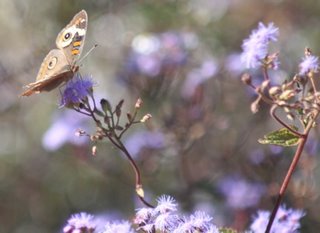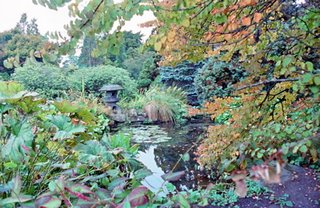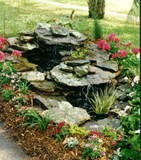 The Buckeye butterflies were playing on the wild ageratum in the Big Branch Wildlife Preserve over the weekend.
The Buckeye butterflies were playing on the wild ageratum in the Big Branch Wildlife Preserve over the weekend. 
A monarch attracted to the wild ageratum
Time to time musings about backyard garden pond building, keeping, troubleshooting. Questions and answers from pond keepers and builders. Occasional excerpts from the pondlady's book, "A Practical Guide to Building and Maintaining your Pond."




 Here in Louisiana we grow sugar cane. In long ago days, the sugar was extracted by hand and the resulting liquid was put into kettles, sometimes as large as 8 feet across. Horses or people then walked round and round the kettle pulling or pulling a large mixer to turn the sugar into syrup. Since this method is no longer used, we have many huge cast iron kettles around. Some people have turned them into ponds. Gotta be one of the great recycling ideas. It is so popular that you can now buy fiberglass 'sugar kettles' and have a pond that you can move and care for easily.
Here in Louisiana we grow sugar cane. In long ago days, the sugar was extracted by hand and the resulting liquid was put into kettles, sometimes as large as 8 feet across. Horses or people then walked round and round the kettle pulling or pulling a large mixer to turn the sugar into syrup. Since this method is no longer used, we have many huge cast iron kettles around. Some people have turned them into ponds. Gotta be one of the great recycling ideas. It is so popular that you can now buy fiberglass 'sugar kettles' and have a pond that you can move and care for easily.


 I built this pond at the end of a driveway in front of the back porch. I talked for a long time to convince the client not to build a pond on the driveway, but could not talk her out of it. So on the driveway, it went. I used cinder blocks for a strong wall, dropped the roofing felt in it and then the liner. After filling it with water, I started covering up the cinder blocks with Arkansas Moss Rock. For what it is, it turned out OK. I put lots of soil in between the rocks, so I could tuck plants in there.
I built this pond at the end of a driveway in front of the back porch. I talked for a long time to convince the client not to build a pond on the driveway, but could not talk her out of it. So on the driveway, it went. I used cinder blocks for a strong wall, dropped the roofing felt in it and then the liner. After filling it with water, I started covering up the cinder blocks with Arkansas Moss Rock. For what it is, it turned out OK. I put lots of soil in between the rocks, so I could tuck plants in there.
